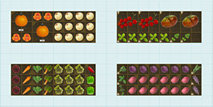How to grow Leek?
- Latin Family: Amaryllidaceae
- Latin Genus: Allium
- Ease of Growing: Easy
- Growing Type: Annual
The leek is a satisfying and straightforward crop to grow. It is easier to grow than the onion, because you don't have to worry about bulbing and day length. Leeks are one of the most trouble-free crops. Leeks grown in the summer can simply be left in the ground all winter, to be harvested as needed for the kitchen.
Videos
Leek History
This non-bulbing relative of the onion was probably derived from A. ampeloprasum. It is native to Eurasia and was first cultivated somewhere in the Eastern Mediterranean. Leeks have been a food of the common people since the ancient Egyptians, as they are easy to grow and have a sweet and delicate onion flavor that is good for flavoring bland staple foods. They are also one of the hardiest of common crops and can grow right through the winter and still be good in early spring, when little else is available.
Soil Preference
- PH (min/max): 6.0 - 7.0
- PH Ideal (min/max): 6.4 - 6.6
Leeks need a deep, rich, fairly [neutral] soil. It should be well drained, because the plants will remain in the ground through much of the winter and are susceptible to rot in wet soil. They do particularly well in deep intensive beds.
Leeks can be planted fairly early in the spring, so gardeners often prepare the growing bed the previous fall.
How to care for Leek?
Leeks need looking after carefully, because they grow slowly and don't have a lot of foliage. They do not form bulbs the way onions do but instead develop thick cylindrical stalks.
Water
Leeks grow best in moist soil. Give the plants constant moisture and apply a mulch.
Fertilizer
Moderate nitrogen. Moderate potassium. Moderate phosphorous.
Leeks aren't a very hungry plant.
Seeds
Seed Viability: 2-4 Years
Germination Percentage: 75.0
Leeks are biennial and will produce their spectacular flowers in their second spring. It's easy to save Leek seed, simply leave the best plants in the ground instead of eating them. Save the seed from at least 12 plants to ensure enough genetic variation.
Leeks are cross-pollinated by insects, so should be isolated by one mile from any other varieties (fortunately there are not likely to be any others nearby). These will produce seed in early summer.
If you need the space for another crop, you can dig the seed leeks from their bed in early spring and move them to a convenient location.
Light
Sun: min. 6 hours daily
Leeks do best in full sun, though they will tolerate some shade.
Conditions:Cold, Cool, Warm
Season:Long Season
Storage
Leeks are so hardy they are usually stored in the ground and harvested as needed (cover with mulch in cold climates). The outer skin may turn somewhat slimy in very cold weather, but the interior should be fine.
Storage Req: Ground
Storage Temp: °F
Storage Length: days
You can store leeks for several weeks in a plastic bag in the fridge.
Storage Req: Refrigerator
Storage Temp: 35-40°F
Storage Length: 1-21 days
In very cold climates you can store Leeks in a root cellar at 32 to 40˚ F. Trim off the excess tops and roots and plant them in a box of damp sand.
Storage Req: Cold, Moist
Storage Temp: 32-40°F
Storage Length: 1-60 days
Problems
Leek Types
- Ramp
- Fall/Winter
- Summer
These varieties tend to be shorter and more cold tolerant than the summer types. They are hardy enough to remain in the ground over the winter, even in cold climates. They tend to have bluish foliage.
These varieties tend to be shorter and more cold tolerant than the summer types. They are hardy enough to remain in the ground over the winter, even in cold climates. They tend to have bluish foliage.
These tall, fast growing leeks aren't very hardy and don't store well. They are grown in summer for immediate consumption.
Pests
- Deer
- Leafminers
- Slugs and snails
- Birds
- Gophers
- Onion Maggot
- Thrips
- Aphids
- Armyworms
- European Corn Borer
- Nematodes
Diseases
- Onion Smudge
- Bacterial Blight
- Rust
- Damping Off
- Downy Mildew
- Fusarium Bulb Rot
- Onion Leaf Blight
- Onion Purple Blotch
